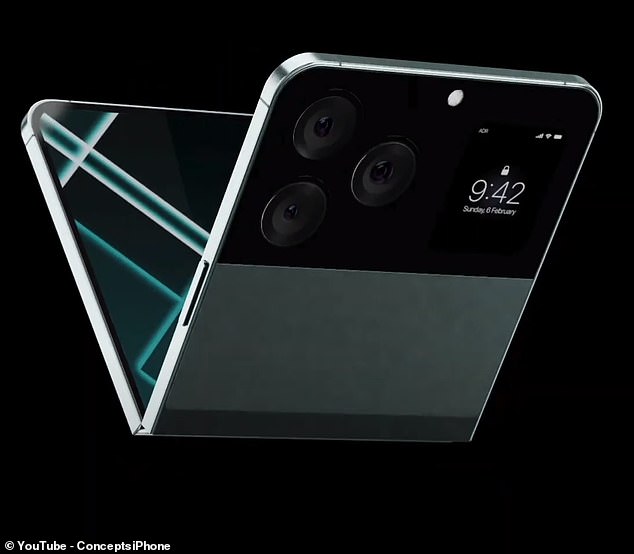After more than a decade quietly exploring the idea, Apple may finally enter the foldable phone market in 2026.
A foldable iPad is also rumored to be in development.
The long-awaited competitor to Samsung’s Galaxy Z, Motorola’s Razr Plus and Google’s Pixel Fold now even has a working title, insiders said: the iPhone Flip.
Apple’s design team has had ambitious goals for its entry into the crowded, niche market of old-school foldable mobile devices, according to these sources, including a high-resolution but rugged display that faces outward when up. folded.
Reports this year indicate that the Cupertino-based tech giant has already contacted at least one component manufacturer in Asia to source parts for two sizes of the iPhone Flip, although there are no plans to mass produce the device in 2024 or 2025.
Experts say Apple’s long-rumored competitor – Samsung’s Galaxy Z, Motorola’s Razr Plus and Google’s Pixel Fold – now has a working title: the iPhone Flip. Above, a rendering by YouTuber ConceptsiPhone, who has been experimenting with foldable iPhone designs for years.
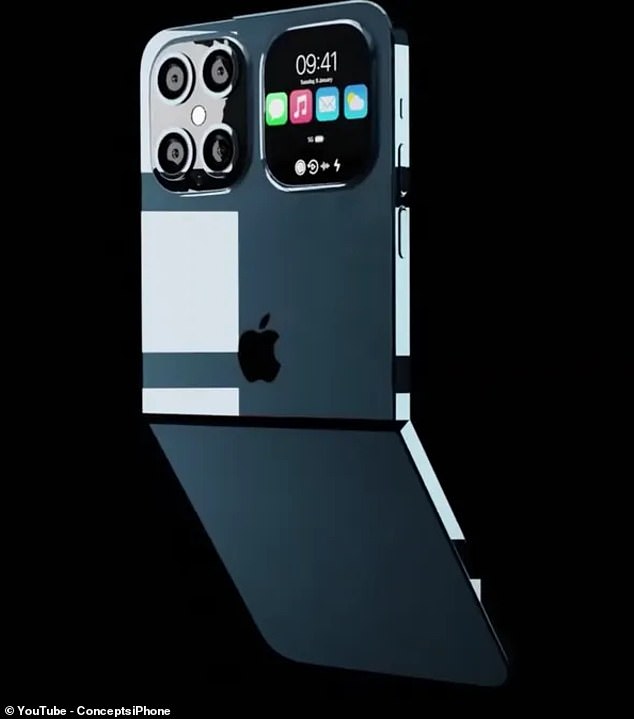
Reports this year indicate that Apple has already contacted at least one component manufacturer in Asia to source parts for two sizes of the ‘iPhone Flip’, although there are no plans to mass produce the device in 2024 or 2025. Above, another recent render By ConceptsiPhone
Sources also suggested that Apple views a foldable iPad as an easier engineering feat and a less risky entry into the market, given falling iPhone sales.
The company sees an ‘iPad Flip’ as a novelty item that could gauge customer interest in its new designs before battling multiple foldable phone rivals on their home turf.
“Apple will only release the product once it is sure, as it cannot afford to lose customers due to a mediocre device,” according to Kaushik Bosean executive at Green Tiger Mobility who has been closely watching the foldable space.
“Manufacturers are not sure about the longevity of foldable displays,” Bose noted in public comments on Quora.
“No one knows if they will really last more than a year or two,” the executive said, “as lines seem to appear on some of the old (first-generation) foldable devices.”
But a new Apple patent, released Thursday, indicates that the company is still hoping to realize its dreams of a unique, quintessential Apple breakthrough in foldable mobile technology: an off-the-fold touchscreen.
The May 2, 2024 patent, titled ‘Electronic device with display and touch sensor structures,’ proposed that the new device will have a ‘flexible transparent wall portion’ as well as ‘opaque walls’ that can be interacted with as ‘touch layers’.
The result could possibly echo the first generations of the iPod.
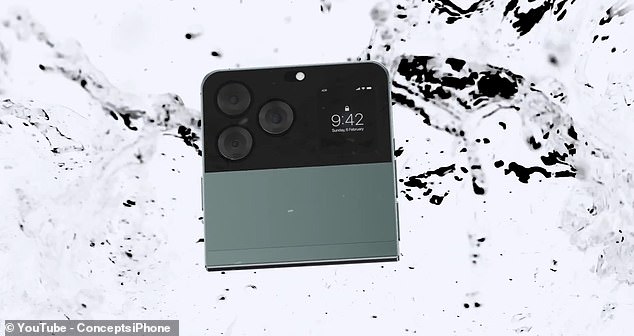
Sources also suggested that Apple views a foldable iPad as an easier engineering feat and a less risky first entry into the market. Above, another recent ConceptsiPhone render
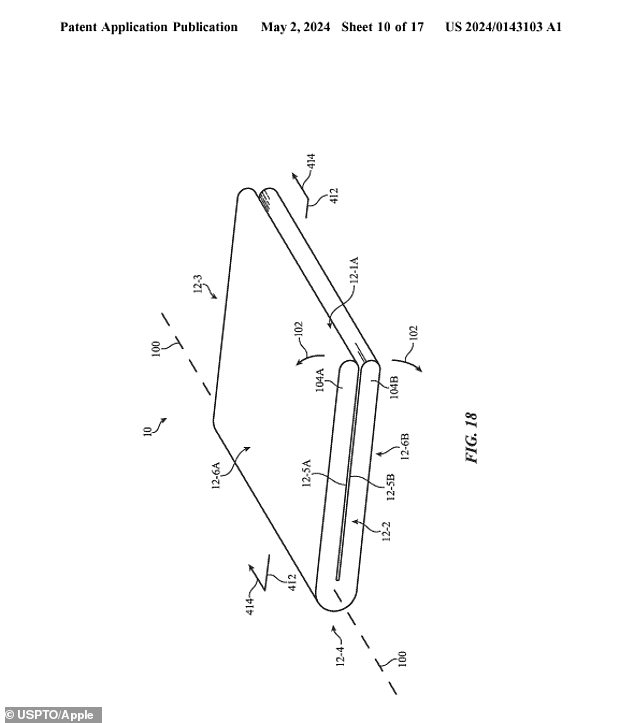
But a new Apple patent, released Thursday, indicates that the company is still hoping to realize its dreams of a unique, quintessential Apple breakthrough in foldable mobile technology: an off-the-fold touchscreen.
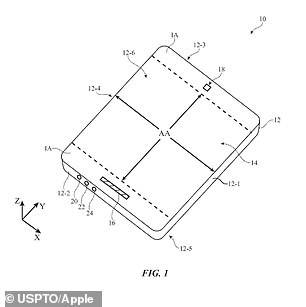
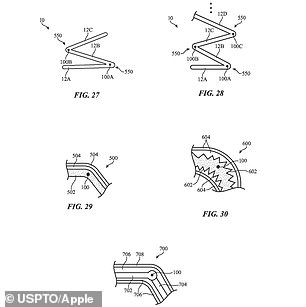
The May 2, 2024 patent, titled ‘Electronic device with display and touch sensor structures’ proposes that the device will have a ‘flexible transparent wall portion’ as well as ‘opaque walls’ that can be interacted with as ‘layers’. tactile’. possibly like the first generations of the iPod
This latest patent lends credence to anonymous internal claims made to the tech news site. Informationalleging that Apple has been secretly working with South Korean flat-screen maker LG and Samsung to create a prototype of its foldable iPad.
According to its current and former Apple sources, the company’s industrial design team wants true thinness for the iPhone Flip, half as thick as current iPhones.
However, limitations related to reducing the size of batteries and touchscreen internals have undermined these grand ambitions for years, they said.
Similarly, Apple has secretly struggled to design a foldable phone with an external display that’s durable enough for everyday use.
A former Apple employee told the site that Apple hardware engineers discovered that prototypes with an outward-facing screen were ‘prone to breaking when dropped.
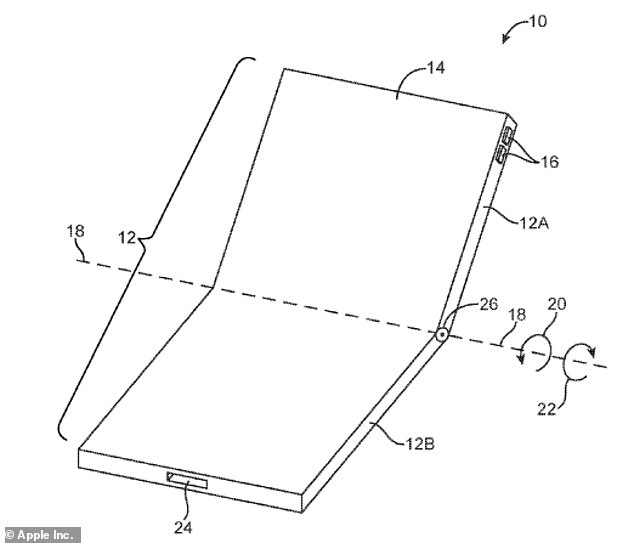
An Apple patent, titled ‘Flexible Display Devices’, filed on October 12, 2018, showed what appears to be a foldable phone. In the patent, you can see a foldable and closed device, similar to a foldable phone, using a hinge in the middle (above)
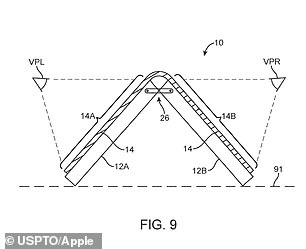
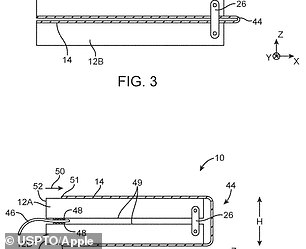
In one form factor, the screen is displayed in a triangular position, where presumably people sitting on either side of the screen could view the same content simultaneously.
Apple’s patents on ‘flexible display devices’ date back more than a decade, with patents filed in 2011 and 2014.
One version of the patent, filed on October 12, 2018, showed a gaming or entertainment trick in which the screen could be placed on a table in a triangular position, where presumably people sitting on either side of the screen could see the same content. simultaneously.
The patent indicates that said device would use a flexible organic LED display.
‘Flexible screens can be mounted on [case] overlapping the hinges,” the patent states.
“When parts of a device’s case are rotated relative to each other, the flexible screen can bend.”
“The hinge can be configured to allow the flexible display to be placed in a front-to-front configuration where one active side of the display faces itself or in a back-to-back configuration.”
As with any patent, it’s unclear if Apple actually plans to develop a device with this feature.
An Apple spokesperson did not respond to DailyMail.com’s request for comment on its most recent foldable patents or The Information’s February report.
In the early days of Apple’s foldable phone rumors, CCS Insight analyst Ben Wood expressed the common opinion that there’s “really no need” for Apple to enter the foldable phone market.
“You can rest assured that you have had flexible display technology in your labs for the last decade,” Wood told MailOnline.
“But there is currently no commercial imperative for Apple to take the risk of getting into a niche market when the iPhone is so incredibly successful.”

